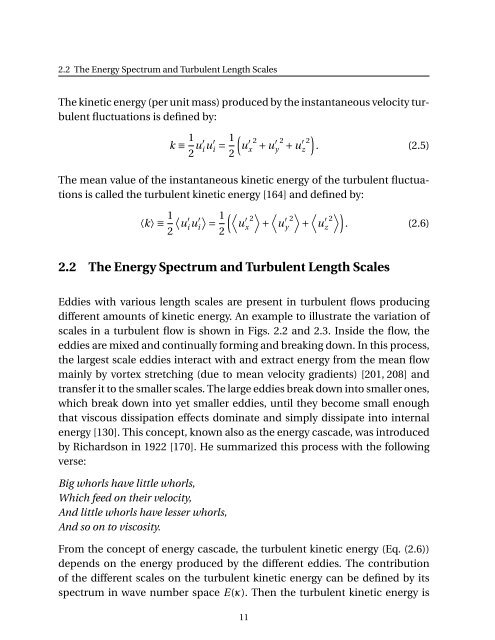Numerical Simulation of the Dynamics of Turbulent Swirling Flames
Numerical Simulation of the Dynamics of Turbulent Swirling Flames
Numerical Simulation of the Dynamics of Turbulent Swirling Flames
Create successful ePaper yourself
Turn your PDF publications into a flip-book with our unique Google optimized e-Paper software.
2.2 The Energy Spectrum and <strong>Turbulent</strong> Length Scales<br />
The kinetic energy (per unit mass) produced by <strong>the</strong> instantaneous velocity turbulent<br />
fluctuations is defined by:<br />
k ≡ 1 2 u′ i u′ i = 1 2<br />
(<br />
u ′ x 2 + u ′ y 2 + u ′ z<br />
2 ) . (2.5)<br />
The mean value <strong>of</strong> <strong>the</strong> instantaneous kinetic energy <strong>of</strong> <strong>the</strong> turbulent fluctuations<br />
is called <strong>the</strong> turbulent kinetic energy [164] and defined by:<br />
〈k〉 ≡ 1 2<br />
〈 〉<br />
u<br />
′<br />
1<br />
(〈 〉 〈 〉 〈 〉)<br />
i u′ i = u ′ 2<br />
x + u ′ 2<br />
y + u ′ 2<br />
z . (2.6)<br />
2<br />
2.2 The Energy Spectrum and <strong>Turbulent</strong> Length Scales<br />
Eddies with various length scales are present in turbulent flows producing<br />
different amounts <strong>of</strong> kinetic energy. An example to illustrate <strong>the</strong> variation <strong>of</strong><br />
scales in a turbulent flow is shown in Figs. 2.2 and 2.3. Inside <strong>the</strong> flow, <strong>the</strong><br />
eddies are mixed and continually forming and breaking down. In this process,<br />
<strong>the</strong> largest scale eddies interact with and extract energy from <strong>the</strong> mean flow<br />
mainly by vortex stretching (due to mean velocity gradients) [201, 208] and<br />
transfer it to <strong>the</strong> smaller scales. The large eddies break down into smaller ones,<br />
which break down into yet smaller eddies, until <strong>the</strong>y become small enough<br />
that viscous dissipation effects dominate and simply dissipate into internal<br />
energy [130]. This concept, known also as <strong>the</strong> energy cascade, was introduced<br />
by Richardson in 1922 [170]. He summarized this process with <strong>the</strong> following<br />
verse:<br />
Big whorls have little whorls,<br />
Which feed on <strong>the</strong>ir velocity,<br />
And little whorls have lesser whorls,<br />
And so on to viscosity.<br />
From <strong>the</strong> concept <strong>of</strong> energy cascade, <strong>the</strong> turbulent kinetic energy (Eq. (2.6))<br />
depends on <strong>the</strong> energy produced by <strong>the</strong> different eddies. The contribution<br />
<strong>of</strong> <strong>the</strong> different scales on <strong>the</strong> turbulent kinetic energy can be defined by its<br />
spectrum in wave number space E(κ). Then <strong>the</strong> turbulent kinetic energy is<br />
11
















